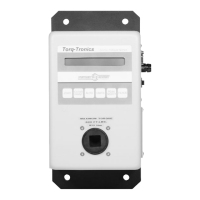
Do you have a question about the Sturtevant Richmont Torq-Tronics 10I and is the answer not in the manual?
| Model | Torq-Tronics 10I |
|---|---|
| Manufacturer | Sturtevant Richmont |
| Category | Test Equipment |
| Communication | RS-232 |
| Torque Units | in-lb, ft-lb, Nm |
| Resolution | 0.01 in-lb |
| Display | LCD |
| Power Supply | AC adapter |
| Operating Temperature | 0°C to 50°C |
| Storage Temperature | -20°C to 60°C |
| Type | Electronic Torque Tester |
| Accuracy | ±0.25% of indicated value, from 20% to 100% of full scale |
Safety advice including eye and hearing protection guidelines for operating torque tools.
Warnings regarding electrical shock from damaged cords and tripping hazards from cables.
Overview of the main components and parts of the Torq-Tronics® tester.
Describes the back plate, mounting holes, LCD display, and key functions.
Explains the Peak Select, Filter keys, transducer, power switch, and fuse.
Details the serial port for data communication and the charger receptacle.
Criteria for choosing a location and steps for physical mounting and electrical connection.
Instructions for optional serial setup, testing, and troubleshooting.
Steps to start the tester, prepare, and test torque wrenches and screwdrivers.
Categorization of tools, suitability, and discussion of testing methods.
Overview of testing procedures for various power tool types, including pulse tools.
Explanation of joint hardness and the function/components of joint simulators.
Steps for measuring rotation and configuring joint simulator washer stacks.
Explains the role of electronic filters in reducing noise and analyzing torque signals.
Procedure to collect data on actual joint torque for filter selection.
Steps for preparing the tester and testing tools under 10 inch-pounds.
Procedures for testing non-shutoff pulse tools, with or without joint simulators.
Steps for testing power tools over 10 inch-pounds using joint simulators.
Steps for calibrating the unit and verifying the accuracy of the calibration.
Addresses using Torq-Tronics® for dial or beam-type torque wrenches.
Explains the features and benefits of the Torque Tool Manager software.
Answers questions on joint simulator springs and how often calibration is needed.
Provides general unit specs, model ranges, and drive sizes for the testers.
Lists supported units of measure and available options/accessories for the testers.
